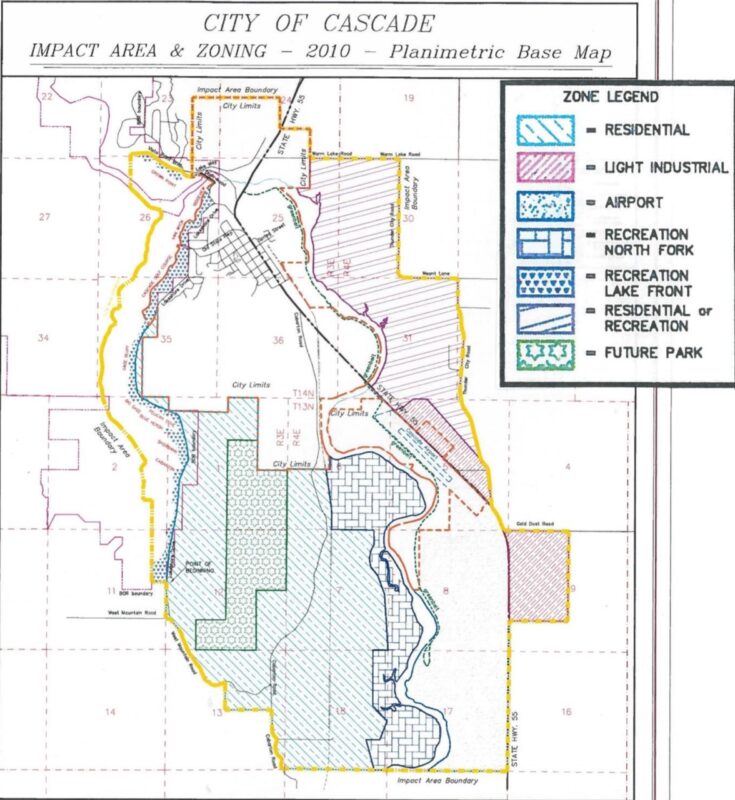The Cascade City Council indicated it might want to get rid of the boundary it uses to define an area where future growth is expected during a meeting on Monday.
The council held a joint meeting with Valley County Commissioners at Cascade City Hall to continue discussions on a review of the current area of impact, which must be completed by 2026 under a state law updated last year by the Idaho Legislature.
Cascade Mayor Judith Nissula told the county that city services would be stretched to capacity just by possible growth in city limits, including some projects that are already entitled.
“You don’t hear cities wanting to shrink their impact area,” Nissula said. “Usually, they’re wanting to expand their impact area, but I think we’re already kind of maxed out.”
Sherry Maupin, who now chairs the Valley County Commission following the retirement of Elt Hasbrouck on Monday, asked Nissula if she thinks Cascade needs an impact area at all.
“I don’t think we do,” Nissula replied.
No decisions were made at Monday’s meeting, but the city council is expected to propose revised boundaries for the impact area to the county later this year.
What is the impact area?
The Cascade Impact Area was established in the late 1970s and most recently adjusted in 2010. Generally, it extends north just beyond Warm Lake Road, south past Gold Dust Road, east to Thunder City Road, and west to West Mountain Road.
Without donors like you, this story would not exist.
Make a donation of any size here
The main function of Cascade’s impact area is to chart areas where the city is likely to grow and generally designate what type of development the city would like to see in certain areas.
Unlike the McCall Impact Area, Cascade’s impact area is subject to the same zoning rules used by the county, and development applications are reviewed by the Valley County Planning and Zoning Commission.

Five-year timeline
One of the key requirements of the state’s new rules for impact areas is that the land within must be likely to be annexed into the city within five years.
“If you’re talking five years down the road, I can’t see us annexing a single square inch into the city,” council member Rachel Huckaby said. “We have more lots in the city for people to build on than could be built in five years.”
Nissula said there has been little to no interest from developers seeking to build in the impact area and annex into the city.
“No one has come knocking on our door, with the exception of the hospital,” she said. “Had their bond passed, they would have made a request to annex.”
In May 2023, the Cascade Medical Center’s $40 million bond for a new hospital a half-mile north of Cascade along Idaho 55 was shot down by voters. A similar bond issue also failed in 2022.
Expected growth, utilities
The other new criteria for determining impact area boundaries are geographic features, expected growth, transportation and utility infrastructure, and other public service district boundaries.
Nissula expects the city to have its hands full just providing city water and sewer service for growth expected from The River District, which could build nearly 450 homes on the east side of Idaho 55 south of the North Fork of the Payette River.
“We’re already in a situation, with the growth that we have now, that we’re going to be drilling a new well to ensure we have (city water) redundancy,” Nissula said.
The River District is expected to be built in five phases. Phase one was approved in 2022 and calls for more than 100 residential units and seven commercial lots, including a Stinker Store gas station that was recently completed.
Jurisdiction and liability
The county commissioners have been signaling since last year that the updated state law is likely to shrink the impact area surrounding McCall, Donnelly and Cascade.
Brian Oakey of the Valley County Prosecuting Attorney’s Office suggested that one of the reasons the law was changed was to clarify that impact area decisions rest with the county.
“The legislature made it very clear that the jurisdiction of the city is within the city limits and everything outside of city limits is the responsibility of the county,” Oakey said.
That clarification has motivated the county to “tighten up” each of the county’s three impact areas, Maupin said.
“When a decision is made in the impact area, the county is liable if something happens,” she said.
Valley County already oversees development applications in impact areas for Donnelly and Cascade, but in McCall a joint P&Z of city and county representatives reviews impact area development applications before making a recommendation to the county commissioners.
That system has recently come to a head following repeated disagreements between the McCall P&Z and the county commissioners over the expansion of a storage unit complex in McCall’s impact area.
“I would not ever want to go back to a situation where cities were making decisions in those impact areas when we have to defend those decisions,” Maupin said.
McCall, Donnelly talks to come
Joint meetings between the county and city councils in Donnelly and McCall are expected to continue negotiations on revised impact areas for those cities later this year.
Each city will make a recommendation to the county on what the boundaries should be, but the decision ultimately rests with the county, Oakey said.






